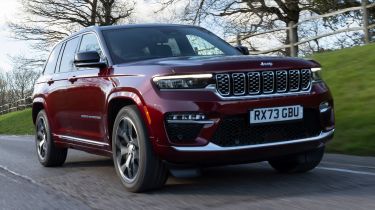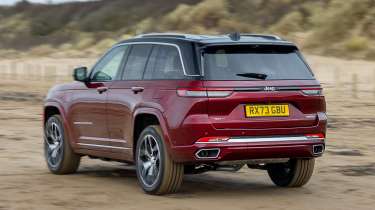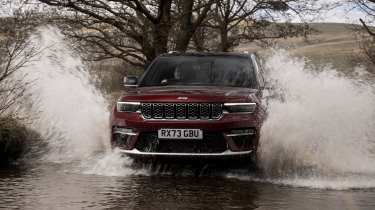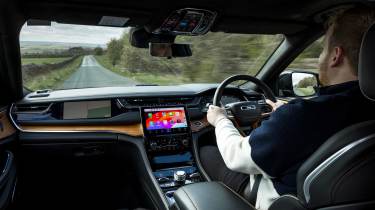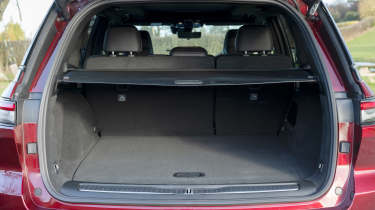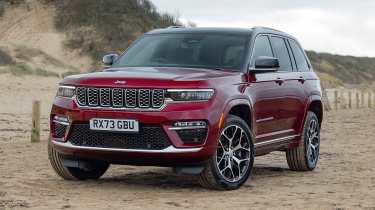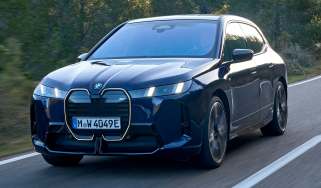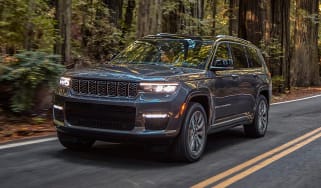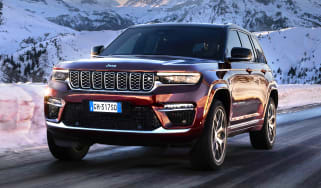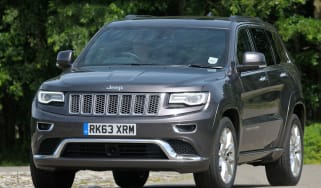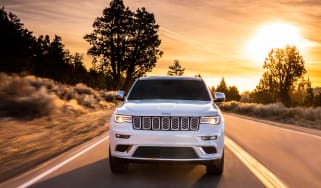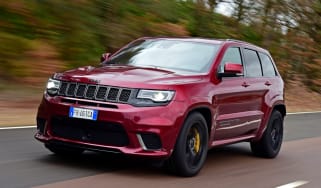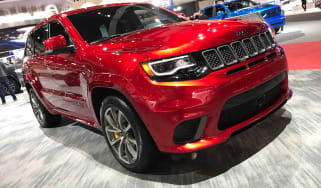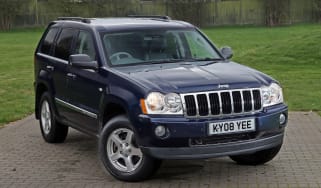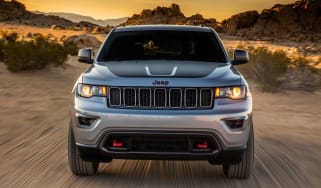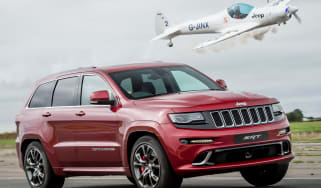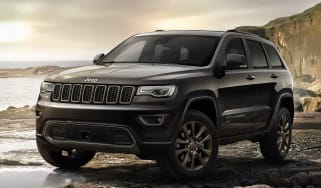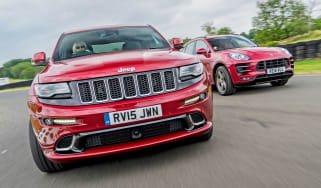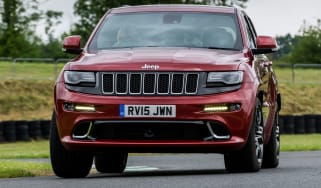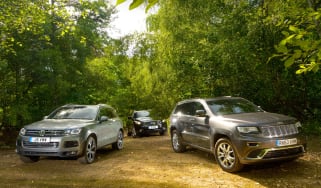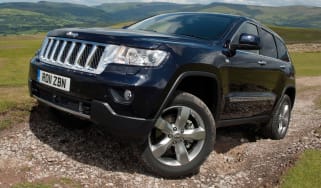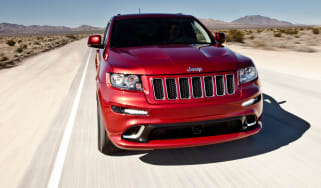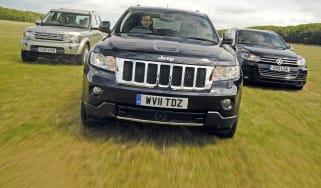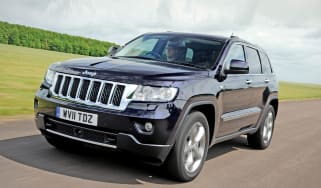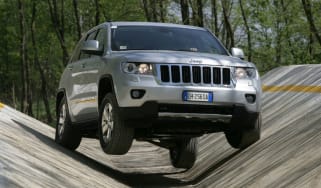Jeep Grand Cherokee review
The Jeep Grand Cherokee struggles to compete with a host of talented SUV rivals at this price point

Is the Jeep Grand Cherokee a good car?
The Jeep Grand Cherokee is decidedly unremarkable. It’s adequate in many respects, but that simply isn’t good enough when prices can reach over £85,000, and similarly expensive rivals include the more dynamic and luxurious BMW X5 and Range Rover Sport. Alternatively, if you’re looking for a premium SUV that can tackle tough terrain head on, the Land Rover Defender is the far superior choice.
|
Key specs | |
|
Fuel type |
Plug-in hybrid |
|
Body style |
5dr SUV |
|
Powertrain |
2.0-litre, 4cyl turbo petrol, 2x e-motors |
|
Safety |
5-star (Euro NCAP) 2022 |
|
Warranty |
3yrs/60,000 miles |
How much does the Jeep Grand Cherokee cost?
With prices ranging from around £72,500 to £86,000, the 2024 Jeep Grand Cherokee isn’t a cheap car. For context, those prices mean the big Jeep is competing with large premium SUVs like the Audi Q7, BMW X5 and Range Rover Sport, and in this company, the Grand Cherokee struggles to compete.
In truth, the UK, or indeed mainline Europe, isn’t natural territory for the Grand Cherokee; it’s a large SUV designed for the highways and large expanses of North America. That said, with Jeep now owned by Stellantis, the current Grand Cherokee should feel more European than models of old.
Take the fact that there’s not a V8 engine under the bonnet. Instead, the sole powertrain available is a 4xe petrol-electric hybrid, giving the Grand Cherokee some green credentials and the potential for low running costs. And unlike many of its rivals, the Grand Cherokee is genuinely good off-road; the ability to venture off the beaten track is one reason to choose the Jeep over its premium rivals.
Used - available now

2019 Jeep
Grand Cherokee
26,500 milesAutomaticDiesel3.0L
Cash £32,490
2015 Jeep
Grand Cherokee
114,495 milesAutomaticDiesel3.0L
Cash £10,895Although the Grand Cherokee was available with a choice of Limited, Trailhawk, Overland and Summit Reserve trim levels, buyers now have a choice of two: Limited and Summit Reserve. Both have a long list of standard equipment, including dual-zone climate control, LED headlights, heated front and rear seats, ventilated front seats, dual-pane panoramic sunroof, 10.1-inch touchscreen infotainment system, 10.25-inch digital instrument panel, rear-view camera, wireless smartphone charging, adaptive cruise control, keyless entry and start, electric tailgate and a suite of driver assistance systems.
The Summit Reserve adds an array of extra equipment, including 21-inch alloy wheels (20-inch on the Limited trim), 16-way electric and ventilated leather seats, 19-speaker premium audio system, ventilated rear seats, four-zone climate control, air suspension, off-road camera, head-up display and customisable ambient lighting. It’s generous, but we’re not entirely sure it’s worth the £13,500 difference in price.
Both models feature the same 2.0-litre petrol-electric plug-in hybrid powertrain that produces 375bhp and 637Nm of torque. These are big numbers, but the 30 miles of electric range from a fully charged battery and combined fuel economy of 88.3mpg to 97.4mpg are just as impressive.
Engines, performance & drive
One reason for the Grand Cherokee’s high starting price is every model comes with a plug-in hybrid powertrain. It consists of a 2.0-litre turbocharged four-cylinder petrol engine, an eight-speed automatic gearbox, and a 17.3kWh battery that feeds two electric motors: one integrated into the transmission that can drive the wheels, and an other motor generator that’s meant to provide seamless start-stop.
The Jeep Grand Cherokee 4xe (to use its full name) offers a pure-electric range of up to 28 miles, or 32 miles in the city. When the e-motor is doing most of the heavy lifting, the Grand Cherokee is relaxing to drive and very quiet inside. It’s complemented by the ‘Quadra-Lift’ air suspension fitted to the Summit Reserve, which delivers a soft ride and wafting quality when cruising. The high driving position also provides a good view of the road ahead with a very commanding feeling, thanks to the bonnet stretching out in front.
Floor the throttle, and the enormous Grand Cherokee accelerates at a surprisingly brisk pace, taking 6.3 seconds to get from 0-62mph. However, doing so guarantees the petrol engine will kick in, and it produces a harsh drone that chips away at any illusions of sophistication. Off the motorway and onto some country roads, there’s a lot of body roll in the corners, and the Grand Cherokee’s numb steering has no strong desire to return to the centre.
As you’d expect for a Jeep, the plug-in hybrid Grand Cherokee is 'Trail Rated', and boasts several off-road specific features and drive modes to help drivers when they go off the beaten track. To prove its rugged credentials, we went rock crawling and wading, and it handled everything we threw at it without fuss on standard road tyres. Admittedly, it didn’t quite skip across obstacles in the same way a Jeep Wrangler does thanks to its 2.5-tonne weight. We also found the camera system that’s supposed to help when traversing along a trail to be of little help because the display is extremely laggy.
|
Model |
Power |
0-62mph |
Top speed |
|
Jeep Grand Cherokee 4xe |
375bhp |
6.3 seconds |
130 mph |
MPG, emissions & running costs
The Grand Cherokee is available in Europe only as a plug-in hybrid, and while this is a step in the right direction for Jeep, it lags behind some of its plug-in hybrid SUV rivals. Take the BMW X5 xDrive 50e, which can travel an impressive 67 miles between charges. That’s more than double the Grand Cherokee’s 27-28 miles on a combined cycle. Even CO2 emissions are relatively high at 65-71g/km, meaning the Grand Cherokee isn’t particularly attractive to company car drivers.
On the plus side, fuel economy of 88.3mpg to 97.4mpg will be alien to anyone who has ever owned a six- or eight-cylinder Grand Cherokee of the past, but you must remember to charge the battery regularly to achieve these figures. Otherwise, you’re simply paying more to carry around a heavy and expensive battery.
Another problem is insurance, with the Grand Cherokee slotting into groups 48 and 49 out of 50. This puts it in line with many performance cars and even supercars, so be prepared to dig deep for insurance cover.
Depreciation might also be another potential issue, because the Grand Cherokee is expected to retain 47 per cent of its original value after three years or 36,000 miles, according to our experts, lagging behind the equivalent plug-in BMW X5 xDrive 50e, which is likely to maintain around 53 per cent, while a Range Rover Sport P460e hangs on to up to 59 per cent over the same period.
To get an accurate valuation of a specific model, check out our valuation tool...
|
Model |
MPG |
CO2 |
Insurance group |
|
Grand Cherokee 4xe Limited |
88.3mpg |
71g/km |
48 |
|
Grand Cherokee 4xe Summit Reserve |
97.4mpg |
65g/km |
49 |
Design, interior & technology
Order books for the latest Grand Cherokee actually opened in the summer of 2022, and it’s easy to tell this isn’t the freshest SUV on the market because the cabin is covered in glossy piano black plastic, which we’ve noticed other brands aren’t using nearly as much nowadays. This material no longer delivers an air of luxury, plus the surface becomes scuffed and scratched all too easily when subjected to the rigours of family life.
The wood trim on the dashboard and steering wheel certainly catches the eye, but it looks like the sort of material you’re more likely to find adorning a kitchen worktop you’d buy from B&Q, and makes the interior feel a little tacky.
We also weren’t impressed by the overall build quality, because there was a lot of creaking from the dashboard and various other bits of trim during our test drive across Yorkshire, along with an irritating ticking noise.
This certainly isn’t the level of quality you’d expect from a large premium SUV with a £72,500 starting price, let alone the top-of-the-range version like we drove, which costs nearly £86,000. That pitches the Grand Cherokee as a rival to the BMW X5, Porsche Cayenne and even the Range Rover Sport, which are all several leagues ahead of the Jeep in this department.
There are now just two trim levels available – Limited and Summit Reserve – and every model is equipped with a 10.25-inch digital driver’s display, 10.1-inch touchscreen, dual-zone climate control, heated front and rear seats, ventilated front seats, adaptive cruise control, electric tailgate, dual-pane panoramic sunroof and Quadra-Trac II four-wheel drive system.
The flagship Summit Reserve adds a more sophisticated Quadra-Drive II four-wheel drive system, electronic limited-slip differential, head-up display, off-road camera, night vision, 18-way electric leather seats, 21-inch alloy wheels, four-zone climate control, Quadra-Lift air suspension, customisable ambient lighting and a front passenger interactive display.
Sat-nav, stereo and infotainment
Unfortunately, the technology onboard the Grand Cherokee doesn’t do much in practice to justify its price tag. The 10.25-inch instrument display and 10.1-inch central touchscreen are relatively sharp to look at, but not the fastest to respond to inputs and Jeep’s Uconnect infotainment system isn’t the most intuitive setup we’ve tried.
Then there’s the third separate display featured in our car, which sits ahead of the front passenger, and we found it very difficult to see even with the brightness turned all the way up. It has limited functions, such as displaying the sat-nav route or some media controls, further bringing into question its validity. The 19-speaker McIntosh sound system failed to make much of an impression, either.
Boot space, comfort & practicality
Space for rear passengers is generous; there’s ample head and legroom for six-foot tall adults, plus room under the front seats for their feet. Those in the back get their own set of climate controls and four USB charging ports, which seems like overkill, but will prevent any arguments over who gets to top-up their device.
Boot space is a generous 520 litres, but that’s no match for the 647-litre boot in the Range Rover Sport. There’s no seven-seat option for the Grand Cherokee, either.
|
Dimensions | |
|
Length |
4,914mm |
|
Width |
1,968mm (or 2,149mm including door mirrors) |
|
Height |
1,795mm |
|
Number of seats |
5 |
|
Boot space |
520 litres |
Safety & reliability
The Jeep Grand Cherokee didn’t feature in our 2024 Driver Power owner satisfaction survey, and the brand didn’t rank in the manufacturer rundown. This is largely due to the fact that Jeep sells relatively few cars in the UK. A three-year/60,000-mile warranty is standard for the industry, but it is disappointing when brands like BMW or Land Rover offer unlimited mileage policies, while some brands provide cover for five or seven years.
Safety experts Euro NCAP awarded the Grand Cherokee a five-star safety rating in 2022, with the SUV achieving an 84 per cent rating for adult occupant protection and child occupant protection. The Grand Cherokee also scored 81 per cent for both vulnerable road user protection and safety assist technologies.
Along with multiple airbags, adaptive cruise control, rain-sensing wipers, automatic high and low beams and a full size spare wheel, the Grand Cherokee has a host of active safety systems, including forward collision warning, traffic sign recognition, blind spot monitoring with rear cross traffic detection and active lane management to keep you in your lane.
|
Key standard safety features |
Euro NCAP safety ratings |
|
|
Jeep Grand Cherokee alternatives
Gone are the days when Jeep and Land Rover had the SUV market almost entirely to themselves. Today, the Grand Cherokee has dozens of rivals, from premium SUVs like the Porsche Cayenne, Audi Q7, BMW X5 and Range Rover Sport, to more affordable alternatives like the Hyundai Santa Fe and Kia Sorento. From 2025, the Grand Cherokee will also face a challenge from within when Jeep launches the all-electric Wagoneer S.
Frequently Asked Questions
The standard Jeep manufacturer’s warranty is three years or 60,000 miles, whichever comes first. This is a bit disappointing when Kia offers cover for seven years, and Hyundai guarantees its cars for five years.
